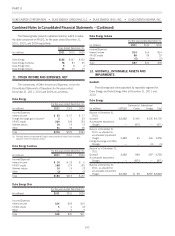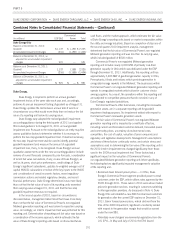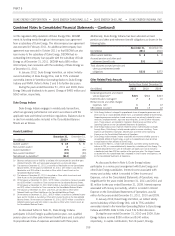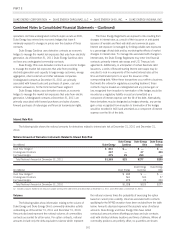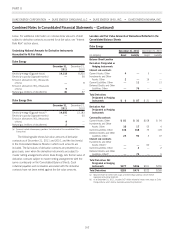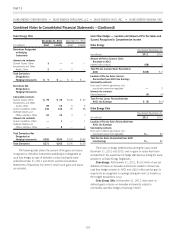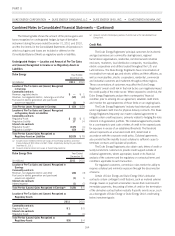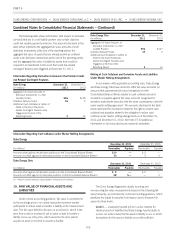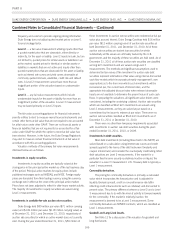Duke Energy 2011 Annual Report Download - page 180
Download and view the complete annual report
Please find page 180 of the 2011 Duke Energy annual report below. You can navigate through the pages in the report by either clicking on the pages listed below, or by using the keyword search tool below to find specific information within the annual report.
PART II
DUKE ENERGY CORPORATION •DUKE ENERGY CAROLINAS, LLC •DUKE ENERGY OHIO, INC. •DUKE ENERGY INDIANA, INC.
Combined Notes to Consolidated Financial Statements – (Continued)
14. RISK MANAGEMENT, DERIVATIVE INSTRUMENTS
AND HEDGING ACTIVITIES
The Duke Energy Registrants closely monitor the risks
associated with commodity price changes and changes in interest
rates on their operations and, where appropriate, use various
commodity and interest rate instruments to manage these risks.
Certain of these derivative instruments qualify for hedge accounting
and are designated as hedging instruments, while others either do not
qualify as hedges or have not been designated as hedges (hereinafter
referred to as undesignated contracts). The Duke Energy Registrants’
primary use of energy commodity derivatives is to hedge the
generation portfolio against exposure to changes in the prices of
power and fuel. Interest rate swaps are entered into to manage
interest rate risk primarily associated with the Duke Energy
Registrants’ variable-rate and fixed-rate borrowings.
The accounting guidance for derivatives requires the recognition
of all derivative instruments not identified as NPNS as either assets or
liabilities at fair value in the Consolidated Balance Sheets. For
derivative instruments that qualify for hedge accounting, the Duke
Energy Registrants may elect to designate such derivatives as either
cash flow hedges or fair value hedges. The Duke Energy Registrants
offset fair value amounts recognized on the Consolidated Balance
Sheets related to derivative instruments executed with the same
counterparty under the same master netting agreement.
The operations of the USFE&G business segment meet the
criteria for regulatory accounting treatment. Accordingly, for
derivatives designated as cash flow hedges within USFE&G, gains
and losses are reflected as a regulatory liability or asset instead of as a
component of AOCI. For derivatives designated as fair value hedges
or left undesignated within USFE&G, gains and losses associated
with the change in fair value of these derivative contracts would be
deferred as a regulatory liability or asset, thus having no immediate
earnings impact.
Within the Duke Energy Registrants’ unregulated businesses, for
derivative instruments that qualify for hedge accounting and are
designated as cash flow hedges, the effective portion of the gain or
loss is reported as a component of AOCI and reclassified into earnings
in the same period or periods during which the hedged transaction
affects earnings. Any gains or losses on the derivative that represent
either hedge ineffectiveness or hedge components excluded from the
assessment of effectiveness are recognized in current earnings. For
derivative instruments that qualify and are designated as a fair value
hedge, the gain or loss on the derivative as well as the offsetting loss
or gain on the hedged item are recognized in earnings in the current
period. The Duke Energy Registrants’ include the gain or loss on the
derivative in the same line item as the offsetting loss or gain on the
hedged item in the Consolidated Statements of Operations.
Additionally, the Duke Energy Registrants’ enter into derivative
agreements that are economic hedges that either do not qualify for
hedge accounting or have not been designated as a hedge. The
changes in fair value of these undesignated derivative instruments are
reflected in current earnings.
Information presented in the tables below relates to Duke Energy
on a consolidated basis and Duke Energy Ohio. As regulatory
accounting treatment is applied to substantially all of Duke Energy
Carolinas’ and Duke Energy Indiana’s derivative instruments, and the
carrying value of the respective derivative instruments comprise a
small portion of Duke Energy’s overall balance, separate disclosure for
each of those registrants is not presented.
Commodity Price Risk
The Duke Energy Registrants are exposed to the impact of
market changes in the future prices of electricity (energy, capacity
and financial transmission rights), coal, natural gas and emission
allowances (SO2,seasonalNO
Xand annual NOX)asaresultoftheir
energy operations such as electric generation and the transportation
and sale of natural gas. With respect to commodity price risks
associated with electric generation, the Duke Energy Registrants are
exposed to changes including, but not limited to, the cost of the coal
and natural gas used to generate electricity, the prices of electricity in
wholesale markets, the cost of capacity required to purchase and sell
electricity in wholesale markets and the cost of emission allowances
primarily at the Duke Energy Registrants’ coal fired power plants.
Risks associated with commodity price changes on future operations
are closely monitored and, where appropriate, various commodity
contracts are used to mitigate the effect of such fluctuations on
operations. Exposure to commodity price risk is influenced by a
number of factors, including, but not limited to, the term of the
contract, the liquidity of the market and delivery location.
Commodity Fair Value Hedges.
At December 31, 2011, there were no open commodity
derivative instruments that were designated as fair value hedges.
Commodity Cash Flow Hedges.
At December 31, 2011, there were no open commodity
derivative instruments that were designated as cash flow hedges.
Undesignated Contracts.
The Duke Energy Registrants use derivative contracts as
economic hedges to manage the market risk exposures that arise
from providing electric generation and capacity to large energy
customers, energy aggregators, retail customers and other wholesale
companies. Undesignated contracts may include contracts not
designated as a hedge, contracts that do not qualify for hedge
accounting, derivatives that do not or no longer qualify for the NPNS
scope exception, and de-designated hedge contracts. Undesignated
contracts also include contracts associated with operations that Duke
Energy continues to wind down or has included as discontinued
160


